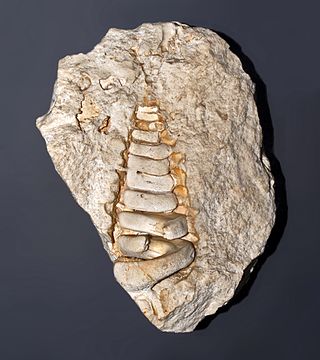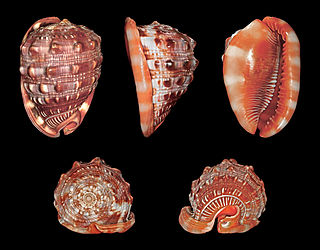
Muricidae is a large and varied taxonomic family of small to large predatory sea snails, marine gastropod mollusks, commonly known as murex snails or rock snails. With over 1,700 living species, the Muricidae represent almost 10% of the Neogastropoda. Additionally, 1,200 fossil species have been recognized. Numerous subfamilies are recognized, although experts disagree about the subfamily divisions and the definitions of the genera. Many muricids have unusual shells which are considered attractive by shell collectors and by interior designers.

Bermuda land snails, scientific name Poecilozonites, are an endemic genus of pulmonate land snail in the family Gastrodontidae. 12 species are known from the fossil record, and 4 of these species survived into modern times, but due to the highly negative effects of human development, the extant species has been reduced down to only bermudensis and circumfirmatus.

Calliostoma is a genus of small to medium-sized sea snails with gills and an operculum, marine gastropod molluscs within the family Calliostomatidae, the Calliostoma top snails. Previously this genus was placed within the family Trochidae. Calliostoma is the type genus of the family Calliostomatidae.

Valvatidae, the valve snails, is a taxonomic family of very small freshwater snails with an operculum, aquatic gastropod mollusks.
Tessarolax is an extinct genus of fossil sea snails, marine gastropod mollusks in the family Aporrhaidae. The fossil shells of these snails are found in Cretaceous to Paleocene deposits in Europe, North America, and Madagascar.
Ficopsis is an extinct genus of large sea snails, marine gastropod mollusks in the family Ficidae, the fig snails.
† Bembexia is a genus of fossil sea snails, marine gastropod mollusks. This genus is placed in the subfamily Eotomariinae, of the family Eotomariidae. The shell characters resemble those of Balbinipleura. These snails have been interpreted as herbivorous, probably grazing on algae.

†Nerinea is an extinct genus of fossil sea snails, marine gastropod molluscs in the clade Heterobranchia.

Cerionidae is a family of air-breathing land snails, terrestrial pulmonate gastropod mollusks in the superfamily Urocoptoidea.

Fasciolariidae is a family of small to large sea snails, marine gastropod mollusks in the superfamily Buccinoidea. Species in Fasciolariidae are commonly known as tulip snails and spindle snails.
Liniaxis is a genus of medium-sized sea snails, marine gastropod mollusks in the subfamily Coralliophilinae, the coral snails, within the family Muricidae, the murex snails and rock snails.
Swenzia is an extinct genus of coelacanthid fish from the late Jurassic of France. It contains a single species, S. latimerae, which was originally described as Wenzia latimerae. Because the generic name Wenzia was already preoccupied by a snail, the generic name was amended to Swenzia. It is the fossil genus most closely related to the living coelacanth, Latimeria.

Freshwater snails are gastropod mollusks that live in fresh water. There are many different families. They are found throughout the world in various habitats, ranging from ephemeral pools to the largest lakes, and from small seeps and springs to major rivers. The great majority of freshwater gastropods have a shell, with very few exceptions. Some groups of snails that live in freshwater respire using gills, whereas other groups need to reach the surface to breathe air. In addition, some are amphibious and have both gills and a lung. Most feed on algae, but many are detritivores and some are filter feeders.

Cypraecassis is a genus of medium-sized to large sea snails, marine gastropod molluscs in the family Cassidae.

Worthenia is an extinct genus of sea snail found in the fossil record. This genus is primarily found in rocks formed during the Devonian to Triassic periods from the central areas of North America. Worthenia was named for the paleontologist Amos Henry Worthen, who lived from 1813-1888.

Persististrombus is a genus of sea snails, marine gastropod mollusks in the family Strombidae, the true conchs.

Ampullinopsis is an extinct taxonomic genus of deep-water sea snails, marine gastropod molluscs in the clade Sorbeoconcha. These sea snails were epifaunal grazers. Sea snails of this genus lived from Paleocene epoch to Miocene epoch.

Naticopsis is an extinct genus of small sea snails belonging to the family Neritopsidae.

Conus is a genus of venomous and predatory sea snails, or cone snails, marine gastropod mollusks in the family Conidae. Prior to 2009, it included all cone snail species but is now more precisely defined, as are other cone snail genera.
Eoconus is an extinct genus of sea snails, marine gastropod mollusks, in the family Conidae, the cone snails and their allies.














